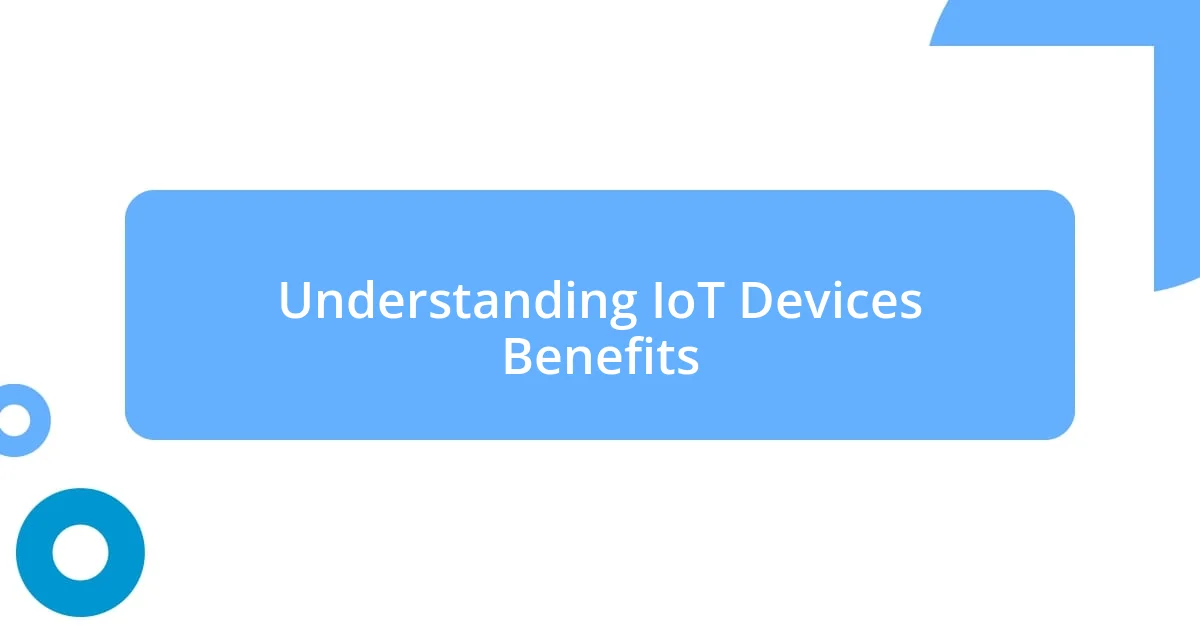Key takeaways:
- Integrating IoT devices enhances operational efficiency, real-time monitoring, and data-driven decision-making, resulting in significant cost savings and improved safety.
- Identifying efficiency challenges through observation and collaborative discussions with stakeholders can unveil hidden inefficiencies and opportunities for automation.
- Scaling IoT solutions successfully requires adaptability, ongoing team training, and strategic integration to foster a culture of continuous improvement and innovation.

Understanding IoT Devices Benefits
One of the most significant benefits of IoT devices is their ability to streamline operations. I remember the first time I integrated smart sensors into my home. Suddenly, I could monitor energy usage in real-time, which led to cutting down on unnecessary expenses. Isn’t it intriguing how a small device can make such a big impact on our daily lives?
Moreover, IoT devices enhance data collection, providing valuable insights for decision-making. I was amazed when my wearable fitness tracker not only logged my activities but also offered suggestions based on my performance. Seeing my progress visualized helped me stay motivated. Don’t you find it fascinating how these insights can drive us to make better choices?
Lastly, IoT devices improve safety and security. For instance, after installing a smart security system, I felt a renewed sense of peace when leaving my home. These devices can alert me to unusual activities in real-time. Isn’t it reassuring to know that technology can provide a layer of protection in our increasingly busy lives?

Identifying Efficiency Challenges
When I first began using IoT devices, identifying efficiency challenges felt like a daunting task. It struck me how often I overlooked simple inefficiencies, like those chaotic mornings when my coffee maker brewed before I was even awake. By pinpointing triggers in my daily routine, I was able to recognize where improvements could be made. It’s amazing how just stepping back and observing your habits can reveal glaring inefficiencies, isn’t it?
In a recent project at work, I noticed how manual processes slowed down productivity. My team and I used to spend far too much time tracking inventory with spreadsheets. Once we implemented smart inventory sensors, I was taken aback by the ease of automatic data collection. It reminded me of how I once struggled with paper trails in my personal life. What a relief it was to realize that technology could eliminate stressors I had grown accustomed to!
To truly unlock the potential of IoT devices, I realized that understanding the challenges is key. I began asking myself specific questions about my daily operations: Where do bottlenecks occur? Are there tasks that could be automated? Reflecting on these questions opened my eyes to new possibilities. It’s incredible how much clarity can emerge once you dare to confront inefficiencies head-on.
| Efficiency Challenge | Example |
|---|---|
| Manual Processes | Tracking inventory with spreadsheets |
| Overlooked Habits | Brewing coffee without planning |
| Poor Data Visibility | Struggling with paper trails |

Selecting the Right IoT Solutions
Choosing the right IoT solutions can feel overwhelming, but it’s essential to align them with your specific needs. I remember sifting through numerous options, each promising to revolutionize my work process, only to find many didn’t quite fit my requirements. I found that a focused approach helped me cut through the noise. Establishing clear criteria based on functionality, scalability, and user-friendliness made my selection process much smoother.
When selecting IoT solutions, consider these factors:
- Business Needs: What specific problems or goals are you addressing?
- Integration: Will the solution work seamlessly with your existing systems?
- Scalability: Can it grow with your business?
- User Experience: Is it intuitive enough for my team to adopt quickly?
- Cost: Does the ROI justify the investment, taking into account both short and long-term benefits?
By examining these aspects carefully, I discovered that the right fit often goes beyond just features; it’s about how well the solution integrates into your overall workflow.

Integrating IoT with Existing Systems
Integrating IoT devices with existing systems can be quite a balancing act. I remember the first time I tried to merge smart thermostats into an outdated HVAC system. The initial resistance from the legacy system was unexpected, but it taught me the importance of compatibility. Have you ever faced a similar challenge, where your plans seemed great until you hit a snag? It made me realize that the integration had to be methodical and well-planned, almost like choreographing a complex dance.
One of the lessons I learned was that proper APIs (Application Programming Interfaces) play a crucial role in this process. As I worked with a vendor to implement inventory sensors, the real breakthrough came when I understood how to link their API with our existing software platform. Honestly, it was like flipping a switch; everything just clicked into place. The data started flowing seamlessly, and it was gratifying to see how quickly the new system enhanced visibility and responsiveness.
Collaboration with my IT team was also key to making integration successful. I vividly remember a brainstorming session where we mapped out our current workflows. Everyone shared insights about potential friction points, and it became clear that involving various stakeholders always yielded better results. When you think about your own experiences, doesn’t it feel rewarding to see different perspectives come together for a common goal? By embracing this collaborative spirit, I found we could integrate IoT solutions more effectively and maximize their value.

Monitoring and Analyzing Data
When it comes to monitoring and analyzing data from IoT devices, I often find myself amazed by the sheer volume of insights that can be extracted. There was a time when I relied solely on manual checks and gut feelings to make decisions. Transitioning to automated data collection was a game changer; it allowed me to access real-time information effortlessly. Have you ever wondered how powerful it feels to see your operations laid out in vibrant, accessible dashboards? It transformed my approach from reactive to proactive.
Utilizing analytics software was another pivotal moment for me. I remember deploying a new platform that provided advanced analytics capabilities, enabling me to slice and dice the data in countless ways. The first time I uncovered a pattern indicating downtime correlated with specific machine settings, I felt like I had unlocked a treasure chest of opportunities for improvement. This data-driven mindset nurtured not just efficiency but also a culture of continuous development within my team.
I also learned the importance of setting up alerts for anomalies in data. Initially, I was hesitant about implementing such features, fearing it might overwhelm us with notifications. But when I finally took the leap, the peace of mind that came from catching potential issues before they escalated was invaluable. Don’t you think it’s crucial to have that kind of safety net? With strategic monitoring in place, I found that my team could focus on innovation rather than firefighting, which ultimately fostered a more dynamic work environment.

Measuring Improvements in Efficiency
Quantifying improvements in efficiency is where the magic of IoT truly comes to life. I remember when I first utilized sensors to track energy consumption in our production line. The immediate data showed a remarkable 20% reduction in energy use over just a few months. Have you ever felt that rush of excitement from seeing hard numbers backing your efforts? It was that tangible evidence that not only reinforced our initiative but also motivated my team to dig deeper into optimization.
Another critical metric we employed was downtime analysis. I vividly recall the day I realized how much insight we could gain from tracking unplanned equipment failures. By deploying IoT-enabled predictive maintenance tools, we reduced our downtime by nearly half. It was enlightening to see how small adjustments based on detailed data analysis could lead to substantial gains. Can you picture how empowering it felt to move from guesswork to solid predictions? It reshaped our strategy and instilled a sense of confidence in the team.
Equally important were the qualitative measures that complemented our quantitative data. Tracking employee satisfaction was something I hadn’t initially considered, but engaging my team’s feedback revealed how tech implementations had eased their workload. After integrating IoT solutions, we hosted informal discussions to gauge morale, and the positive responses were overwhelmingly validating. Doesn’t it feel rewarding when efficiency improvements resonate on a personal level, fostering an environment where everyone thrives? This holistic view played a crucial role in ensuring that our efficiency gains were sustainable and meaningful.

Scaling IoT Solutions for Future
Scaling IoT solutions for the future is as vital as the initial implementation itself. I clearly recall the moment we decided to expand our IoT framework beyond just our production line. It was a bold step, engaging various departments and integrating their unique needs—each voice added a piece to our puzzle. Have you ever been on a team where a collective vision sparked creativity? That’s exactly what happened, as we discovered synergies we hadn’t anticipated.
The scalability of IoT isn’t just about adding more devices; it’s about cultivating a mindset of adaptability. I remember facing challenges with data compatibility as we brought in new technologies. Instead of seeing this as a setback, I viewed it as an opportunity to innovate. We developed frameworks that allowed data from various sources to communicate effectively. Honestly, isn’t it thrilling to turn obstacles into stepping stones? This kind of flexibility prepares us for future advancements and ensures we remain on the cutting edge.
Planning for future scalability also involves investing in training our team. I once underestimated how crucial it was for everyone to feel empowered with the right tools and knowledge. After a few sessions of hands-on training, I noticed a fascinating transformation—team members who were initially hesitant became champions of our IoT initiatives. Could there be anything more inspiring than watching your team thrive by embracing technology? The energy shifted, and it made a world of difference not only in their confidence but also in our overall productivity.













